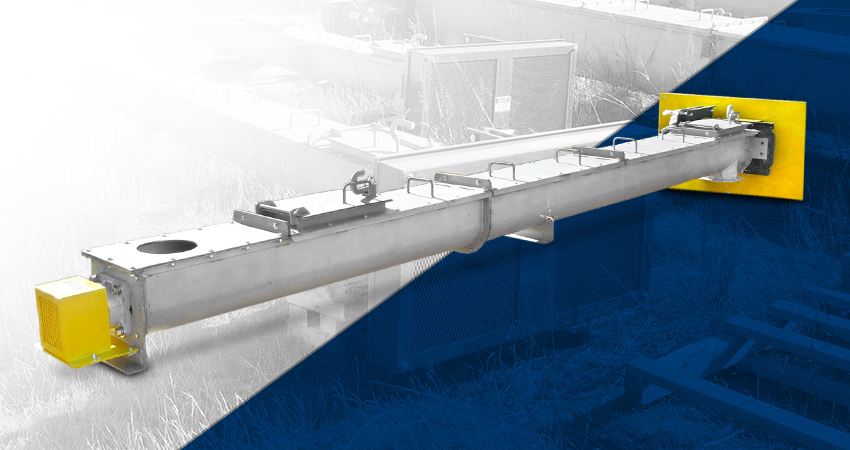Designing Reliable Screw Conveyors Demands Thorough Analysis of Materials
In a billion-dollar global manufacturing industry, where material handling is a critical part of the production process, any unplanned interruption to the daily operation can cost a business hundreds of thousands of dollars per hour in productivity.
For a material handling operation that utilizes screw conveyors in its processes, reliability is the only thing between downtime and lost profitability.
Just as there is no one-size-fits-all solution for a screw conveyor, there is no instant remedy when something goes wrong. Balancing all of the processing and material demands with the appropriate screw conveyor design, components and features is critical for achieving optimal operating efficiency and maximum ROI.
Material Analysis
While the screw conveyor is a common equipment selection for thousands of industrial and manufacturing applications that move a variety of bulk materials from one process to another, the material they move varies dramatically.
Screw conveyors can handle a full range of materials, from semi-fluid and dry to sluggish and free-flowing. Each material’s characteristics should be thoroughly identified before purchasing a screw conveyor. A misapplication of a single design element, from the trough or helix design to the blade shape, can spell disaster for a production process.
Real screw conveyor reliability comes from identifying the distinct material characteristics and aligning each component of your screw conveyor to ensure the very best possible outcome for efficiency and reliability. This is where the CDM custom designed screw conveyor can provide immediate value.
Helix Design
When it comes to moving heavy, abrasive materials in a screw conveyor, the basic helicoid screw, if misapplied, will not be able to survive the wear and tear inflicted by these materials.
A screw conveyor utilizing a thinner helicoid screw construction performs well with materials exhibiting high flowability. However, this design cannot hold up to the punishment of more abrasive or caustic materials that are often found in a 24/7/365 production process.
Heavy-duty applications require a heavy-duty screw conveyor that features individual, highly durable sections fastened to form the screw flight. Without such custom modifications to a conveyor’s design, breakdowns are as inevitable as the lost productivity and lost revenues.
Designing a Difference
The following are features impacting a screw design. These features will have an impact on the screw conveyor’s effectiveness moving materials and its overall reliability.
Ribbon Screw
A CDM ribbon screw conveyor can be used for handling sticky materials and substances that might separate during conveying. The goal with a ribbon screw conveyor design is to eliminate the undesired segregation of large from small materials and light from heavy materials. By taking into consideration the distinct material flow characteristics, you can easily estimate the thorough mixing of materials using a ribbon screw.
Sectional Flighting
While sectional flighting is incredibly durable, manufactured from steel plate and formed into a helix, it is also available in different levels of thicknesses depending on how abrasive the application. If you understand your material qualities, CDM can match the appropriate thickness for the greatest durability and efficiency.
Variable Pitches
Whether your material is extremely fluid or presenting a more uniform movement, variable pitches on the screw flights can be used to optimize the conveying process. CDM can identify combinations that are best suited for distinct material characteristics.
Cone
Wherever mass flow screw feeders are utilized, there is often a cone on the center pipe of the screw that creates a tapered inside diameter (ID). The tapered ID provides a higher volume rate than the preceding pitch and it is very effective at accurately metering the flow of the bulk material from the bin above. Cones can help with one material, but if misapplied can obstruct flow with another material.
Shaftless
The CDM shaftless design features a conveying surface providing easier movement of materials exhibiting challenging characteristics. When it comes to handling bulk materials with high moisture content, CDM considers the shaftless screw conveyor an ideal choice for those sticky or sluggish materials.
Cut Flighting
A slight variation of the single flight screw, a cut flight features small notches in the flighting to break up material during conveying. These unique flights may shred materials as they convey, which may or may not be the desired outcome, but it illustrates how custom choices can impact the outcomes.
Conclusion
Many of our customers consider CDM’s custom-engineered screw conveyors to be an ideal solution for their bulk material handling challenges. With more than 40 years of experience building the highest-quality, longest-lasting conveyors for heavy-duty industrial applications, CDM will provide honest evaluations, expert insights and ultimately the most effective and efficient systems for maximizing your profit margins. Screw conveyors are the most widely utilized conveyors in the world, but it is important to understand their limitations and how CDM can ensure you overcome them.
———
About CDM
The CDM story is about recognizing every industrial operation is different, as are their conveying challenges. A custom-engineered conveying system is a cost-effective approach to any operation willing to look at the value of having a partner who is vested in your success and one who stands by their product. CDM has earned more than 91 percent repeat business because we’re more than just a conveying systems manufacturer – we’re a business partner.
For further information contact:
Andrew Parker, President CDM Systems, Inc.
Browse By Benefit
Categories
- Blog (40)
- Case Studies (9)
- News (7)
- Product Information (7)
- Tech Briefs (3)
- Technical Documents (33)
- Uncategorized (1)
- Videos (12)
- White Papers (5)


